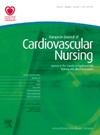Relationship between duration of heart failure and nutritional status in hospitalised patients - preliminary cross-sectional study
IF 3.9
3区 医学
Q2 CARDIAC & CARDIOVASCULAR SYSTEMS
引用次数: 0
Abstract
Introduction Heart failure (HF) is a chronic disease which is one of the most common causes of hospitalisation of elderly patients. Nutritional status has a crucial impact on the course of disease and survival. HF frequently occurs with nutritional deficits, which may lead to malnutrition and loss of skeletal mass, which makes the prognosis worse. Nutritional status depends also on the patient's economic status, ability to prepare meals, and availability of fresh vegetables and fruits. Knowledge of the connection between the duration of heart failure and nutritional status will enable selection of patients with a higher risk of malnutrition, for which nutritional support should be considered. Purpose The study aims to assess the variability of nutritional status in heart failure patients over the duration of the disease, using the Mini Nutritional Assessment (MNA) and Geriatric Nutritional Risk Index (GNRI). Methods The nutritional status of 134 patients with HF admitted to the cardiology department was assessed with the MNA questionnaire. Additionally, GNRI has counted from serum albumin concentration, weight and height of patients. Patients were divided according to the duration of HF into two groups, one with patients with equal or less than five years of history of disease and the second with patients with HF lasting more than five years. Results The mean age was 52.4±16.9 years, 20.2% of patients were women, and the mean LVEF was 30.3±13.8%. The group of patients with HF lasting equal or less than five years was younger than patients with more than five years of the disease (49.5±16.9 years vs. 57.3 ±16.2 years, p=0.002). There were no significant differences in sex, LVEF and NYHA class between the two groups. According to MNA and GNRI scores, the nutritional status had no differences between the group of patients suffering from HF for more than five years compared with those with HF lasting 5 years or less (p=0.50; p=0.63, respectively). Moreover, the time of HF lasting was not correlated with scores of MNA and GNRI (p=0.33; p=0.22). Conclusions The study found no significant association between the nutritional status of patients and duration of heart failure. Therefore, monitoring nutritional status is crucial, irrespective of the duration of HF. It is necessary to analyse this issue in a larger group of patients with heart failure to identify specifically which patients are at risk of malnutrition and how nutritional status changes with the duration of the disease.住院患者心力衰竭持续时间与营养状况之间的关系--初步横断面研究
导言心力衰竭(HF)是一种慢性疾病,是老年患者住院治疗的最常见原因之一。营养状况对疾病的进程和存活有着至关重要的影响。心力衰竭常伴有营养缺乏,可能导致营养不良和骨骼质量下降,从而使预后恶化。营养状况还取决于患者的经济状况、准备膳食的能力以及新鲜蔬菜和水果的供应情况。了解心力衰竭持续时间与营养状况之间的关系,就能选择营养不良风险较高的患者,并考虑为其提供营养支持。目的 该研究旨在使用迷你营养评估(MNA)和老年营养风险指数(GNRI)评估心衰患者在病程中营养状况的变化。方法 采用 MNA 问卷对 134 名心内科收治的心力衰竭患者的营养状况进行评估。此外,还根据患者的血清白蛋白浓度、体重和身高计算了 GNRI。根据心房颤动持续时间将患者分为两组,一组是病史等于或少于五年的患者,另一组是心房颤动持续时间超过五年的患者。结果 平均年龄为(52.4±16.9)岁,20.2%的患者为女性,平均 LVEF 为(30.3±13.8)%。心房颤动持续时间等于或少于五年的患者比持续时间超过五年的患者年轻(49.5±16.9 岁对 57.3±16.2岁,P=0.002)。两组患者在性别、LVEF和NYHA分级方面无明显差异。根据 MNA 和 GNRI 评分,心房颤动持续 5 年以上的患者与心房颤动持续 5 年或不足 5 年的患者相比,营养状况没有差异(分别为 p=0.50 和 p=0.63)。此外,心房颤动持续时间与 MNA 和 GNRI 的评分无关(p=0.33;p=0.22)。结论 研究发现,患者的营养状况与心力衰竭持续时间无明显关联。因此,无论心衰持续时间长短,监测营养状况都至关重要。有必要在更大的心衰患者群体中对这一问题进行分析,以具体确定哪些患者有营养不良的风险,以及营养状况如何随病程变化。
本文章由计算机程序翻译,如有差异,请以英文原文为准。
求助全文
约1分钟内获得全文
求助全文
来源期刊

European Journal of Cardiovascular Nursing
CARDIAC & CARDIOVASCULAR SYSTEMS-NURSING
CiteScore
5.10
自引率
10.30%
发文量
247
审稿时长
6-12 weeks
期刊介绍:
The peer-reviewed journal of the European Society of Cardiology’s Council on Cardiovascular Nursing and Allied Professions (CCNAP) covering the broad field of cardiovascular nursing including chronic and acute care, cardiac rehabilitation, primary and secondary prevention, heart failure, acute coronary syndromes, interventional cardiology, cardiac care, and vascular nursing.
 求助内容:
求助内容: 应助结果提醒方式:
应助结果提醒方式:


